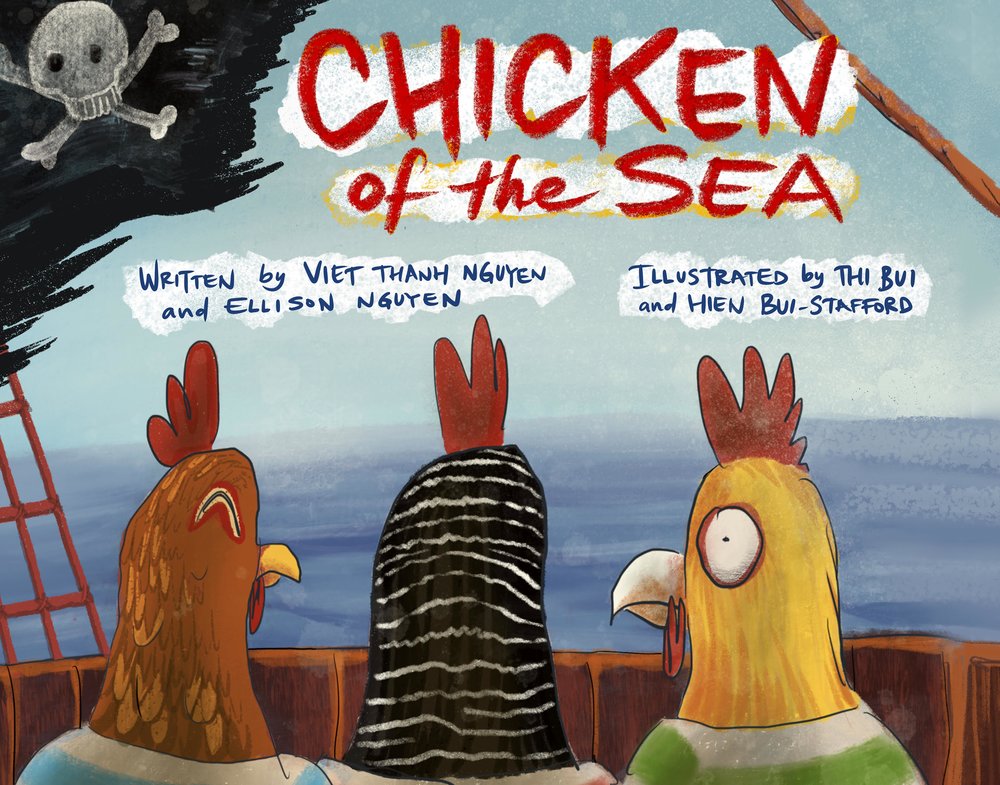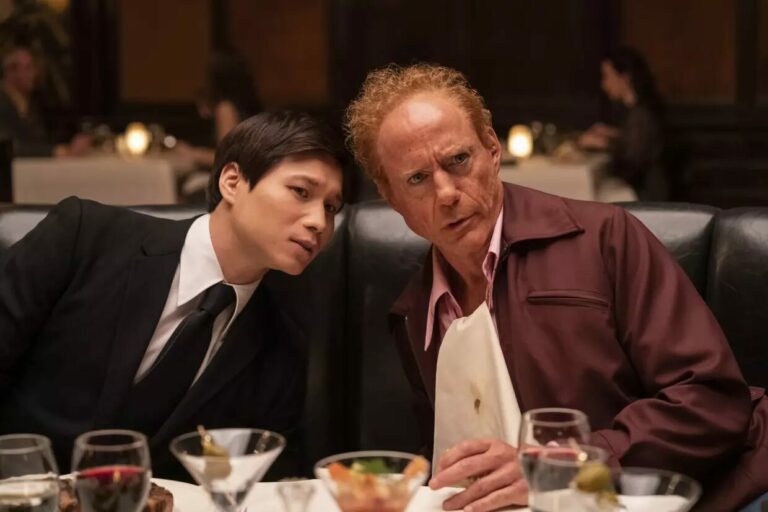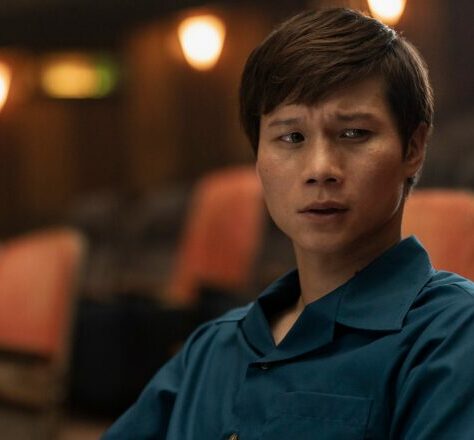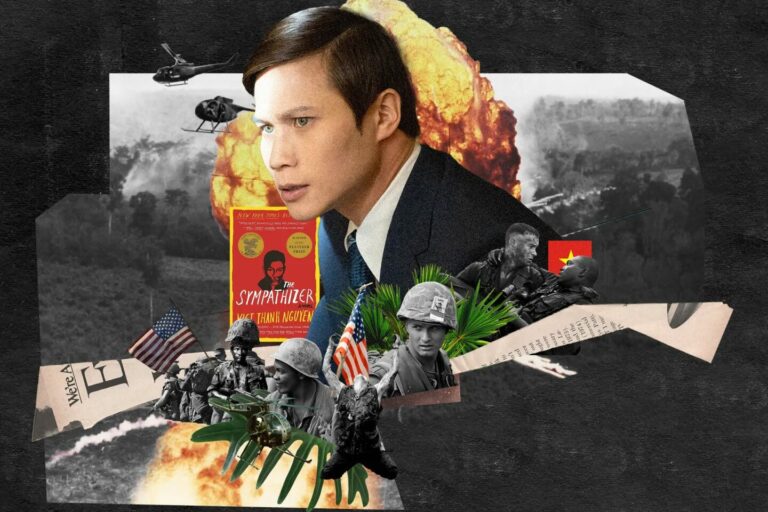Zoë Ruiz interviews Viet Thanh Nguyen, Ellison Nguyen, Thi Bui, and Hien Bui-Stafford about the collaboration needed for Chicken in the Sea for The Millions.
When it comes to my favorite writers, I keep up to date with what they’re writing, winning, saying, doing—you get it. Yes, I’m the type of person who has Google alerts set up for multiple writers (Claudia Rankine, Renee Gladman, Amina Cain, and Tiphanie Yanique, to name a few) and, if they are on Facebook, I receive notifications when they post, which is how I found out about Chicken of the Sea.
On June 13, 2018, Viet Thanh Nguyen posted: “Ellison’s first, and hopefully not last, co-creative effort with me. He came up with the title, story, and illustrations, while I wrote it…I believe he was inspired by his time at the Djerassi residency with illustrator Thi Bui, who gave him a lot of attention.”

I thought, If I were an editor at a press, I’d publish that book.
A couple of weeks later, he posted again: “On an otherwise bleak day, let me just note that Ellison Nguyen, 4 years and 11 months, has obtained a literary agent to represent him (and me) on his book CHICKEN OF THE SEA, which I mentioned here on Facebook and which led an editor from a notable press to express interest in said book. More details to come on this collaborative project with artist Thi Bui and her son Hien providing the illustrations, and Ellison and me working on the story (which was his idea).”
Damn, what a cool book project! I thought.
When I read Chicken of the Sea, written by Viet Thanh Nguyen and his now six-year-old son, Ellison Nguyen, and illustrated by Thi Bui and her now teenage son, Hien Bui-Stafford, I remembered the years I worked with students at the literary nonprofit 826 Valencia and 826LA. Students wrote stories often paired with illustrations by professional, local artists, and the stories were often wild and absurd. Their stories surprised and delighted me, they brought me joy. These days it is rare for me to encounter stories that delight and surprise me, that bring me joy. Chicken of the Sea, a wild, action-packed story in which farm chickens become pirates and sneak into the enemy territory of Dog Knights, is one of these rare stories. What’s more: the multigenerational collaborative book project has the potential to inspire artists, writers, parents, and children to collaborate with one another.
I had the opportunity to interview Viet Thanh Nguyen, Ellison Nguyen, Thi Bui, and Hien Bui-Stafford, and sent them questions via Google documents. Viet typed out Ellison’s responses, and I edited questions and answers for pacing and coherence.
The Millions: Ellison created Chicken of the Sea shortly after his time at a six-day writing residency where 10 Vietnamese diasporic writers gathered at Djerassi Resident Artists Program. Viet, you described the residency as a “huge moment” for Vietnamese diasporic writing. Can you elaborate on why it was a huge moment?
Viet Thanh Nguyen: Vietnamese diasporic writing is flourishing in many countries, and yet many Vietnamese diasporic writers feel as if they’re writing alone, or at least in isolation from other Vietnamese diasporic writers. I think it was important to bring a group of them together so that they could have conversations with each other and build a community, and also to demonstrate to outsiders that such a thing as Vietnamese diasporic literature exists.
These 10 writers are only part of a larger group of writers with books published and awards won. The residency was the first of six events (three of which have taken place) that will bring together more than 40 writers from the United States, Canada, Australia, Germany, France, and Vietnam. We were building on momentum and hoping to further that momentum for Vietnamese diasporic writing, and we did so in the spirit of community and collaboration. We wanted to help these writers and have them help each other, rather than treat writing as only an individualistic practice (which it most basically is, but it also flourishes in the space of movements). There’s no doubt that Chicken of the Sea, itself a collaborative project, was sparked by this collaborative space.
TM: Thi, how would you describe your time with Ellison at the retreat?
Thi Bui: Viet and I had just presented The Displaced at BookExpo in New York, where Hien met Viet for the first time, and then we flew back to San Francisco, Hien went home with his dad, and I went straight to Djerassi. That’s where I first met and spent time with Ellison (along with some literary heavyweights like Nam Le, Monique Truong, and Hoa Nguyen and reconnected with writers I already knew like Bao Phi, Aimee Phan, and Nguyen Phan Que Mai). I love having a little kid at writers’ or artists’ retreats—while it’s harder for the parents, it’s a wholesome addition for everyone else and pure joy for me to have someone to play with when I need to escape from my brain.
I showed Ellison how to do fake kung fu moves and gave him a lot of piggyback rides. Like, a lot. I also drew him in the copy of A Different Pond that Bao Phi and I signed for him.
TM: How was this collaborative project different from previous artistic collaborations you’ve done? (I’m thinking of A Different Pond, and how different it is from Chicken of the Sea.)
TB: I knew that Hien would have good instincts for illustrating Ellison’s ideas, and that his quickness and spontaneity would be a better match. My adult carefulness would fill in the gaps in the preplanning and finalizing of the art. It was kind of awe-inspiring to watch how casually Hien approached the compositions and the character designs. I want that kind of freedom.
TM: I read that you decided to color Hien’s illustrations. One of the things I enjoyed about Chicken of the Sea is the color scheme. The colors are bold and bright; they are loud. Why did you choose these colors for Chicken of the Sea? How do the colors complement both Hien’s illustrations and Ellison’s story? I especially loved the illustration of the Dog King’s heart.
TB: Hien and I chose general colors for the mood of the pages when we were laying out the text and the first thumbnail sketches. The action sequences called for exciting colors! And the page where the Dog King’s heart grows is a homage to the 1966 animated movie of Dr. Seuss’s How the Grinch Stole Christmas!.
TM: Hien, I find that the illustrations pair so well with the story. The facial expressions and body language of the chickens lend to a comical and playful tone. Is this normally how you illustrate, or did Ellison influence your style?
Hien Bui-Stafford: Ellison definitely influenced my style. I was also influenced by the playfulness of little kids. For this book, I drew fast and didn’t really look at anything to copy; I just drew from my imagination. Other times, I actually looked up a lot of reference photos and took more time.
TM: What would be your ideal, dream art project?
HBS: Designing a robot.
TM: Thi and Hien, based on your experiences, do you recommend artists and writers and/or parents and children work on collaborative creative projects?
HBS: Yeah.
TB: It’s a lot less lonely working with collaborators, especially when you can work in the same place at the same time. It’s also nice to wear a slightly different hat than I normally wear as a parent.
TM: I read that you spent a day making and looking at art in Rome. Can you describe that day in Rome and how Chicken of the Sea fit into it?
Hien: My mom was coloring that day. I was just drawing random stuff and giving my mom advice.
TB: I am always behind on my projects, partly because I try to do too many things at the same time, and partly because I always have more to add to what I’m working on. So we were juggling a research month in Greece where I was learning about the refugee crisis there, a mother-son summer vacation, finishing Chicken of the Sea, and killing time because we missed our flight from Rome to Athens. Hien had had enough of the crowds of tourists visiting ancient ruins in the heat, so we found an outdoor cafe with shade across from the National Gallery of Modern Art. Hien gave me guidance on the Dog Knights’ clothing and armor. We had at least a couple of iced cappuccinos and then we went to look at some art, and I was pleased with how much Hien responded to modern and contemporary art.
TM: Ellison, congrats on receiving your first advance at such a young age!
VTN: An advance is the money you got for your book.
EN: Where is it?
VTN: I kept it.
EN: Give it!
VTN: You owe me money.
EN: No.
VTN: You’re expensive.
TM: Ellison, can you tell me about what it was like working with your dad on your story?
EN: It was great.
VTN: Exclamation point?
EN: No.
TM: Viet, can you describe your experience co-creating a story with Ellison?
VTN: It was a real joy. I love watching Ellison create his own stories, which are comic books.
EN: I don’t do comic books anymore.
VTN: You did.
EN: I’m not selling anymore comics. I’m not making any more comics.
VTN: Your agent will be sad.
EN: Okay, okay!
VTN: Does that mean you’ll make more comics?
EN: Dogs of the Air.
VTN: What’s that?
EN: Dogs make a hot air balloon and fly up into the sky but then the hot air balloon blows up and they find treasure in the water. We done here yet?
TM: [Laughs.] Almost! I am curious: what was the last book you loved?
EN: Dav Pilkey’s Dog Man: For Whom the Ball Rolls.
TM: What book (or books) are you reading now?
EN: Diary of a Wimpy Kid: Roderick Rules—
VTN: On Audible.
EN: Disney Frozen 2: The Magical Guide.
TM: Viet, you wrote that June 26, 2018, the day Ellison obtained literary representation, had been “an otherwise bleak day.” Did this news help offset or alleviate the sense of bleakness? Do you believe that art and community as well as fatherhood can function to do so?
VTN: Art, community, fatherhood all bring challenges, but if they are done right, they also bring great joy. As a writer and a reader, I find joy in literature, and of course I want my son to enjoy what I do. We spend a lot of time reading books together, and so it was wonderful for me to see him become an early reader and then, surprisingly, a writer and artist, although as he points out above, that may be ending soon. Even if his writing career goes no further, however, he’s had fun, and it turns out he’s pretty good in front of an audience reading from his book. Hopefully he’ll remember the experience. And the memory of the joy remains. Even now, I remember the fun of how this book came into being, and I don’t remember what was so bleak on June 26, 2018 (Don’t remind me.).
TM: Lastly, what are two or three of your favorite children’s books and why?
VTN: I loved the Curious George series and the Tintin series, probably because both had a great sense of adventure in their own ways, as well as unlikely plots with surprising twists and turns. They were also marked by distinctive visual styles that charmed me and remained consistent over the series. Curious George and Tintin also never changed or aged. They knew who they were, they pursued getting things right in their own ways, and always solved the challenges they faced (even if, in the case of Curious George, he created them himself).
As an adult, I can certainly see some of the possible problems at the heart of these stories’ conceptions, which are inseparable from colonialism, but reading them with Ellison, I can see their enduring power. But while part of the pleasure of sharing storytelling with him is about seeing how entertained he is, the other part of the pleasure is trying to help him understand the complexities of the stories he loves. We’ll have to wait and see how successful I am.


